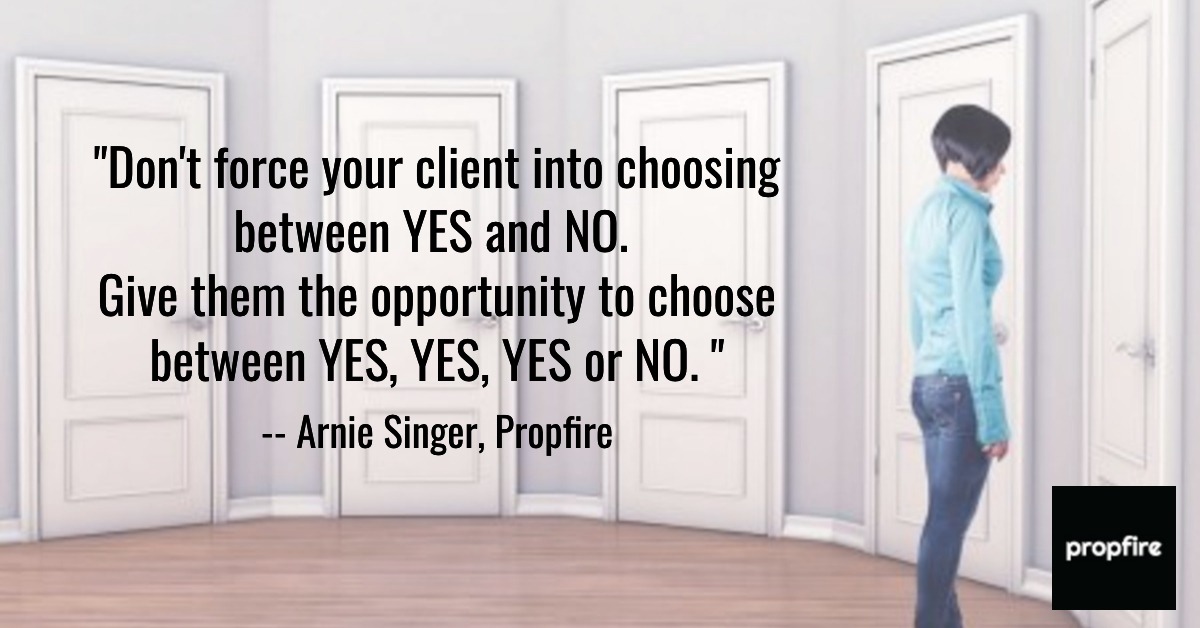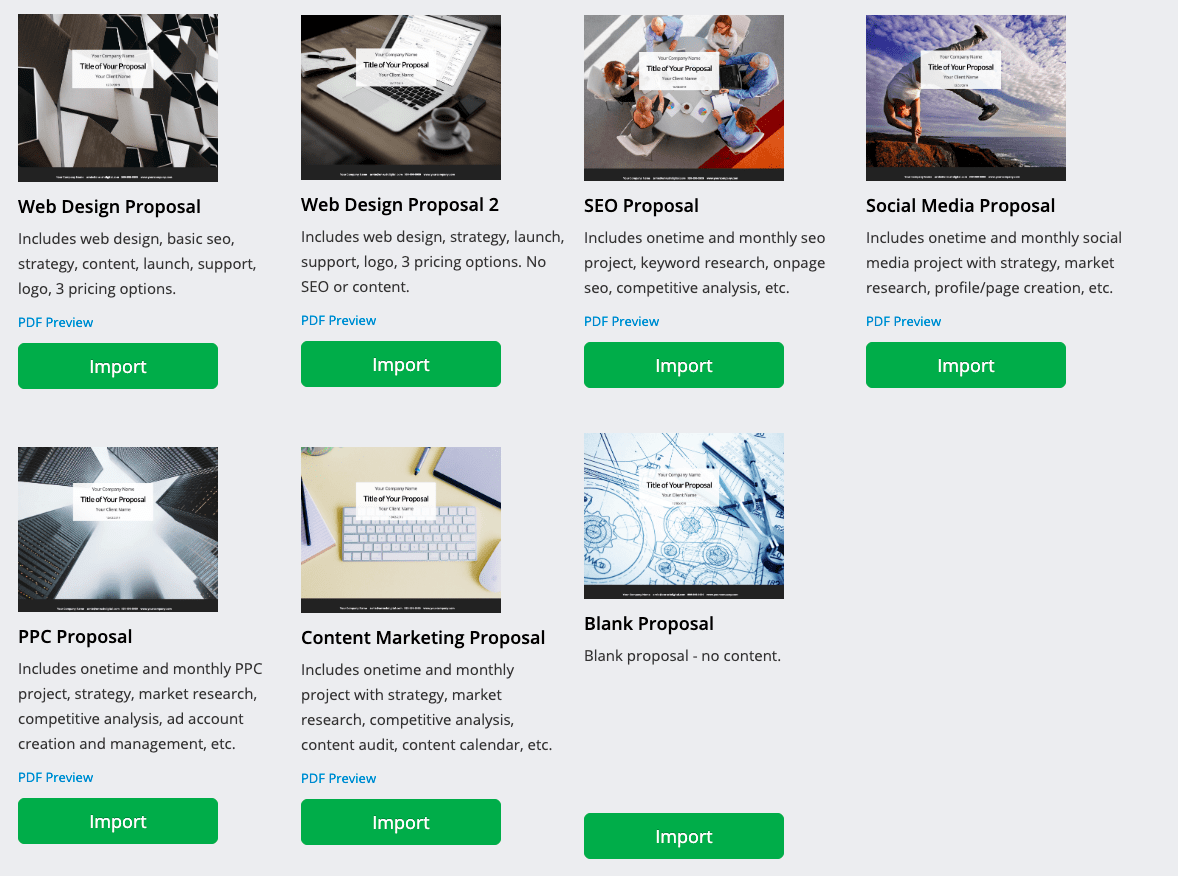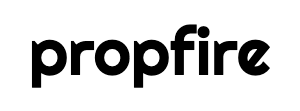Writing a business proposal can be stressful for consultants, freelancers and agencies, whose livelihoods depend on pitching projects and services to clients and closing deals. That’s why it always surprises me how many of these professionals are clueless regarding how to write an effective proposal.
What is a business proposal?
A business proposal is a document you present to a potential client that specifies the services or work you will provide along with a time estimate and price.
Business proposals are usually written documents, but they can also be presented in video form. It doesn’t really matter how your business proposal is presented, as long as your offer is clear and the client understands and accepts it.
But for the purposes of this post we’re going to focus exclusively on written business proposals.
Components of a Business Proposal
What are the different components of a business proposal template?
1. Cover Page
2. Objective
3. Scope of Services
4. Process
5. Timeframe
6. Pricing
7. Terms
8. Signature or Acceptance Section
There are other components you can add to your business proposal if you feel the need, such as an about us section. Some people recommend adding social proof too.
The reason I haven’t included these two elements in our list is because, as I indicated before, you should ideally be presenting your business proposal to a client who you’ve already met with at least once and who knows who you are (even if it’s just from your website and social profiles).
In that case, it’s superfluous to include an “about us” section or social proof to someone who already knows that information. And if you feel compelled to add those elements, then you probably haven’t done your prerequisite work, and you’re just sending a “cold” proposal — which is NOT what you want to be doing if you’re looking to actually win business.
Cover Page
The cover page of your business proposal should contain your company name and contact info, your proposal title, your client’s name and the proposal date.
The truth is that you can present a business proposal without a dedicated cover page and simply include the cover information on the first page of your proposal. But having a cover page makes the proposal look more professional, which is always a good thing.
You can also add a background image to your cover, or not add one. It’s really a matter of taste. I’ve done successful business proposals both ways. On Propfire, we provide business proposal templates with cover images, but we also give users the option to create a cover without a background image.
If your business proposal will primarily be viewed online, including a background image could add an attractive design touch. If your proposal will be exclusively viewed as a printed document, then printing a full color background image might end up being more of a pain than it’s worth.
Objective
The objective section of your business proposal is where you summarize the solution you will be providing the client. You preferably want to frame that solution to reflect the benefit that the client will be receiving.
For example, if you are presenting a digital marketing proposal, your objective could be, “to increase client’s revenue by driving more traffic to the client’s website and converting that traffic into qualified prospects using digital marketing strategies including SEO, PPC and Social Media marketing.”
In this example you’ve stated the benefit you’ll be providing, and how you’ll achieve that objective.
Your objective section should be as brief and concise as possible, so that you don’t end up losing the client’s attention before he gets to the important parts of your proposal.
People have VERY short attention spans. Writing a page long analysis of the client’s business and including general statistics and graphs, might seem super corporate and “professional” — but the reality is that the client is looking for a service provider to solve a problem that he knows he has.
There will be plenty of time to provide strategic business consulting solutions down the road, once you’ve already been hired. You business proposal is not the place for that.
What you want to do is provide the client with the most concise presentation of what you are offering to provide, so that he can quickly digest it and accept it. Your objective could be as short as one or two sentences, but should not be longer than 2 paragraphs.
It really depends on the service your offering and the expectations of the client your pitching to. A smaller client might be happy with reading just a sentence or 2, while a large, Fortune 500, company might be expecting a longer objective section — just because it’s what they’re used to.
Scope of Services
The Scope of Services section of your business proposal clearly states the deliverables or services that you will provide for the client. It can either be in paragraph form or in a bulleted list. Bullets keep it concise and easier for the client to read.
You’ve already most likely discussed these services and deliverables with the client at a meeting or on a call. This is just a summary. You want the client to able to easily figure out what you’re offering so that he can make a quick decision. The more concise and structured, the easier you’ll make that happen.
Here’s an example of the Scope of Services section of a web design proposal:
-
- Map out the page structure and architecture of the website.
- Provide client with recommendations of content that should be created for website.
- Create a user-friendly navigational structure that allows users to easily access the specific content they are seeking.
- Create visual design that enhances and conveys the client’s brand and messaging, and that presents the website content in a visually appealing manner to increase its effectiveness.
- Create fully responsive visual design to assure that website looks great on all devices including desktop, tablet and mobile.
- Provide all stock images needed for the website design and optimize images provided by client.
- Implement basic SEO best practices for each page.
- Add capability to follow client on social media.
- Install and configure the WordPress Content Management System (CMS) that will allow client to easily update and make changes to the website.
- Optimize website for speed, to assure that all pages download quickly.
- Install and configure security software to protect website from hacking and maleware attacks.
- Launch website on hosting platform chosen by client.
- Provide post launch support to troubleshoot problems directly related to the development of the website.
- Train client in how to use content management system to add, modify or delete website content and how to maintain website.
Your Process
In this section you should explain your process, explaining how you will work the client to get the project done from start to finish. This can also be in paragraph or list form, but I recommend using a bulleted list, to make it easy for the client to read and digest.
Here’s a process section example from a PPC Proposal:
Our goal is to make the process of working together as smooth and seamless as possible.
- Once we enter into a formal agreement, we schedule a discovery meeting to fully understand our client’s objectives and requirements. We will then create a project plan, and schedule additional discovery meetings if needed.
- Based on our discovery, we will conduct all of our research and analysis, as described in the Scope of Services, and create a comprehensive PPC marketing plan.
- Upon client approval of the marketing plan, we will implement the plan.
- We will be in regular contact with the client to obtain any information required to perform our work and to answer any questions the client has.
In addition to informing the client of your process, it also sets clear guidelines for the client to follow if he decides to work with you. It also communicates what you expect of a client with whom you work, which can prevent misunderstandings and miscommunications down the road.
Project Timeframe
This one is pretty self explanatory. Give the client a timeframe that you a comfortable with sticking to.
And then finish ahead of schedule!!
Business Proposal Pricing
Here’s where you get to tell the client how much they’ll need to pay for the privilege of having you work for them.
You should ideally try to give the client 3 pricing options, each one providing more services. Research shows that doing this has both practical and psychological benefits — and makes it easier for the client to accept an option. To read an in-depth analysis of this pricing strategy, click here.
Consulting guru Alan Weiss teaches to never frame your pricing as a “yes” or “no” choice; instead, present your clients with a choice of “yes’s.”
In other words, don’t force your client into choosing between YES and NO. Give them the opportunity to choose between YES, YES, YES or NO.
Everyone loves having choices. You walk into a clothing store and there are a dozen different kinds of jeans or shirts. You aren’t just presented with one style to take or leave.
You want to have options. It makes you feel like YOU are in control of your destiny, instead of the person selling to you.
Consulting company McKinsey has compiled statistics over the years that show how providing “different flavors of the same thing” can improve your firm’s chances of selling in a solution by at least 30%.
How do you create pricing options?
The simplest way is to first decide on the service that you’d ideally like to provide and that you believe to be optimal for the client. Make that option 2.
Then strip off some of the features of option 2 until you have the barest bones version, which is the minimum service level that you are willing to provide. That’s option 1.
Finally, add extra features onto option 2 to come up with your dream plan, which you would LOVE to provide your client — and you’ve got option 3.
The statistics say that your client is most likely to choose the middle option — #2 — in which case you’ve succeeded and gotten exactly what you hoped for.
The existence of option 3 makes option 2 look cheaper, so the client feels he’s getting a better deal. At the same time, the existence of option 1 makes the client feel like he’s getting more value (which he is) by choosing option 2.

Here’s an example from website design and development:
When a client asks you to build a website for him, he looks at the project as a single entity with one deliverable.
But you know that building a website contains many different components including strategy, structure, design, development, content, seo, special features, optimization, launch, training and support.
What you need to do is break out these component and then combine them into your 3 options.
The first, and cheapest, option would contain just a website without any content or seo services. Even though you know that you could add tremendous value by providing the client with content and seo services, in the event that the client either doesn’t have the budget for or simply doesn’t grasp the importance of these vital services, you still have the opportunity to get the business with your option 1 pricing plan.
Your second option is going to include content and SEO, and possible other elements that you deem relevant. You’ll price this option at the number you ideally expect to make for this kind of project.
Then you’ll create a third option that includes extra features or additional content and seo or addition support and maintenance or a combination of any or all of the above. This is your exclusive plan that is more expensive than option 2. It’s the plan that you’d love to get, but you’d still be happy if you just got option 2.
Now it’s the client’s choice. And you win with whatever plan the client chooses.
You might initially think that offering pricing options won’t work for your particular service. But you should think twice, because while it might not work for every service, it will work for most. All you need to do is be a bit creative to come up with various options by breaking down your service into smaller pieces.
[For more information about pricing web design proposals, click here.]Should you include a breakdown of your pricing by service or deliverable (like an itemized price list)?
Unless the client demands it, I highly recommend that you DO NOT give the client an itemized price breakdown. The reason is that it gives the client the green light to try to bargain you down on price by asking you to remove specific services — even when those services are integral to the project.
For example, let’s look at a $10,000 web design project broken down into its components:

Seeing this breakdown, the client might say, “let’s get rid of content, seo and mobile” to cut the project price in half. But you know that a website without seo, good content and mobile compatibility is worthless to the client — and not the kind of website you’re willing to build.
You can definitely breakdown the project pricing for yourself, but I would not show it to the client. Most clients just want to see the total figure anyway.
Of course, you should definitely explain to the client the various components of your project, but without price itemizing them.
Proposal Terms
This section includes payment schedule, payment form, cancellation policy etc.
Don’t go crazy with terms.
The last thing you want is for the client to feel like he has to get his lawyers involved. Alan Weiss, author of Million Dollar Consulting Proposals says, “You want to stay out of the other person’s legal department because it will slow down the process and may stop the sale all together.” The less legalese in your proposal, the better.
Here’s an example of a Terms section from a PPC proposal:
- Payment for initial month must be made in full upon signing of proposal, prior to project start.
- Monthly payments must be made add the beginning of the month. Work will begin only after monthly payment is received.
- Onrush Digital retains complete ownership of all deliverables until final payment is made and balance owed is paid in full.
- Payments can be made to Onrush Digital LLC or via paypal to payments@onrushdigital.com.
- This proposal is valid for 30 days.
Signature or Acceptance
You should always include a way for the client to accept your proposal. This could be a space for a handwritten signature or a field for an e-signature depending on what firm your proposal is in.
No need for a separate contract — your proposal is your contract.
Simple is better — and just as legal.
Here is an example of a signature section from a business proposal created with Propfire:

Notice the section title Next Step. It’s a clear call to action that tells the client exactly what he needs to do to accept your business proposal.
Template Design
Contrary to what proposal software companies would like you to believe, clients do not choose vendors based on the design or beauty of their proposals (unless you are a creative design agency, in which case design does matter).
As long as your proposal is professional looking and neatly laid out, it’s the content — specifically services, timing and pricing — that are going to make or break you at this stage.
Relationships, trust, service and pricing are what win proposal.
But, of course, you still want your business proposal to look great and make a positive impression on the client.
On the other hand, you don’t want your proposal to be over-designed — especially if you’re dealing with a client who want to print out your proposal (which is the case with many “old school” type of industries like manufacturing, distribution, construction etc).
Too many images, graphs and design elements can make printing challenging, depending on the type and quality of the client’s printer. And if the executive reading it wants to get to the important info, the images and design frill could get in the way and frustrating.
A business proposal template should contains the content elements we listed above, along with a professional design.
At Propfire we’ve created a series of templates you can use to create your business proposals with.

Timing is Important
Once you’ve created your proposal you need to get it to your client as quickly as possible. The longer it takes you to get it to your client, the more time he has to get busy with other things and forget about you. As the man said, “strike while the iron is hot”.
You don’t take a few days or a week to create a proposal — which is really easy to happen if you’ve got other work and distractions pulling you away.
If the client is ok with just viewing the proposal online, great. In most cases the client will probably want a PDF copy he can print out (another reason why lots of design elements and images is a bad idea).
Follow up
Emailing your proposal to your client is not the end of the process. You need to follow up in a day or 2. If you’ve built a relationship of trust, it shouldn’t take the client long to accept your proposal.
But unfortunately, the client might have other, more pressing, concerns to deal with and your proposal might end up getting lost — which is why you MUST follow up at regular intervals.
Don’t stop until you get a YES (or a no)!
Prerequisite to Business Proposal Writing
The first thing to remember is that a business proposal is not a sales tool or pitch.
As Alan Weiss, the author of Million Dollar Proposals, says, “Proposals are not part of the sales process. They are part of the implementation process. The sale occurs before the proposal is ever written.”
Your business proposal should only be presented after you’ve already spoken with the potential client and have a meeting of the minds regarding the work that is required and the budget.
If you’ve done that, then the client has already bought into using you. Now he only needs to know:
- what exactly you’re going to do
- how long it will take
- how much it will cost.
The proposal is a summary of what you’ve already discussed.
Clients choose vendors based on skill, experience, deliverables, timeline, price and, most important of all, trust. Timeline, price and deliverables are laid out in a proposal. The other elements are developed during relationship building conversations and meeting.
If you haven’t developed any sort of relationship or trust with the potential client, then you’re better off asking for a meeting then simply sending a proposal that will be added to the pile of other proposals received. You don’t want to be in a pile. The chances of winning in a pile are very slim, unless you’re willing to be the lowest price in the pack or you already have a known reputation.
Let’s start from the very beginning and assume that you have never created a business proposal.
A better way
Propfire is built to help you do exactly what I just described in this post — create effective proposals faster and easier.
Try it free for 14 days — no credit card required — to see if it’s a good fit for you.







Trackbacks & Pingbacks
[…] if you have some sort of relationship with the client, and can present your web design proposal in a “face to face” meeting (in-person, video, phone), then you have the opportunity of […]
[…] recently submitted a detailed business proposal to a potential client for an ecommerce website I estimated at around $15,000. A week later the […]
Leave a Reply
Want to join the discussion?Feel free to contribute!